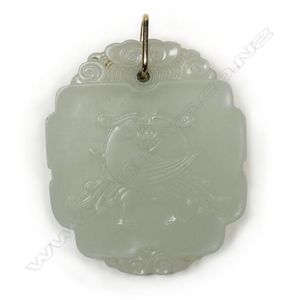Qing Dynasty Jade Pendant with Bird Carvings
An important Chinese Qing Dynasty green-white jade shaped rectangular pendant plaque, 18th/19th century one side is carved in low relief with two birds in mirrored stance, and on the reverse with an auspicious square four-character seal within an intaglio border, and above on both sides with a lingzhi panel. The semi translucent stone is of even green-white colour. 5.7 x 4.8 cm. Cf. 15 similar pendant plaques in the Lizzadro collection sold at Christies Ny, 2013. Provenance: Purchased by our vendor from Ada Lum Antiques in the Mandarin Hotel Hong Kong in 1973 reputedly for equivalent NZ$5000.
You must be a subscriber, and be logged in to view price and dealer details.
Subscribe Now to view actual auction price for this item
When you subscribe, you have the option of setting the currency in which to display prices to $Au, $US, $NZ or Stg.
This item has been sold, and the description, image and price are for reference purposes only.
- Intaglio - A term used to define a method of decoration most common in glassmaking and jewellery which involves engraving, carving or moulding an image into the background, leaving an impression, and leaving the top surface of the item flat, the opposite to relief carving, and also know as counter-relief.
- Qing Dynasty - The Qing Dynasty was the last imperial dynasty of China, ruling from 1644 to 1912. It was established by the Manchu people, who originated from the northeastern region of China. The Qing Dynasty was preceded by the Ming Dynasty and followed by the Republic of China.
- Ming Dynasty - The Ming Dynasty was a ruling dynasty of China from 1368 to 1644. It succeeded the Yuan Dynasty and preceded the Qing Dynasty. The Ming Dynasty was established by Zhu Yuanzhang, a former Buddhist monk who became a rebel leader and eventually overthrew the Mongol Yuan Dynasty. During the Ming Dynasty, China experienced a period of relative stability and prosperity. The government was centralized and bureaucratic, with the emperor at the top of the hierarchy. The Ming Dynasty is known for its cultural achievements, including the development of porcelain, the invention of movable type printing, and the construction of the Great Wall of China.
- Important - Important is a word used in the antique trade to indicate an object should be ranked above other similar objects, and is therefore more valuable.
The object could be considered important because it is by a famous designer or maker, has been shown at a major exhibition, is of exquisite workmanship, is rare or is a "one-off", was made for an important patron, and so on.
Even further up the pecking order are objects that are described in catalogue descriptions as highly important or extraordinarily important.
This item has been included into following indexes:
- Chinese jade, carved animals and other - various carvings 1,657
- Chinese jade, other - plaques and panels 289
-
Chinese seals / chops
- jade jadeite 64
- stone and hardstone 157
